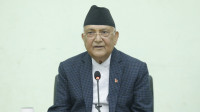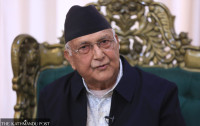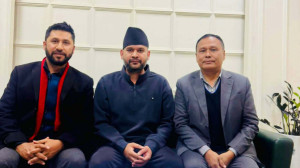Politics
As counting nears end, picture of new House emerges
Congress leads in first-past-the-post tally, UML hopes to catch up with proportional representation votes.
Tika R Pradhan
Six days after the November 20 federal and provincial polls, counting of the first-past-the-post (FPTP) votes is in the final stage and as such tentative strength of the parties in the federal lower house is becoming clear.
As of this writing, as many as 151 of the 165 FPTP seats have already been declared while counting on remaining ones continues. (Counting at the three constituencies—Syangja-2, Dolakha and Bajura—is yet to start.)
“We will finish counting the FPTP votes in two-three days except in three constituencies,” said Shalikgram Sharma Poudel, spokesperson for the Election Commission. “The commission is studying the situation in those constituencies.”
The commission is undecided on whether to start counting or go for re-polling at the polling centres where disputes persist.
Re-polling was held at the Budhinanda Municipality-5 of Bajura district on Saturday. According to Dhakaram Poudel, chief election officer of the Bajura district, the election there was peacefully held with 60 percent turnout.
“A study team of the Election Commission was here today. We are waiting for its report,” said Poudel. “We are still undecided on whether to begin counting or prepare for repolling.”
Though Chief Election Commissioner Dinesh Thapaliya had assured that FPTP votes around the country would be counted within three days, the process remains incomplete even after six days.
With 52 wins and lead in 3 seats, Nepali Congress is set to be the largest party in the upcoming House of Representatives, followed by the UML with 39 wins and 3 leads.
This Election Commission data as of Saturday evening suggests Congress could get 56 FPTP seats (even as it sat in the second place with 2,096,728 votes under Proportional Representation system) while the UML is likely to win 42 FPTP seats (and is leading with 2,182,622 PR votes).
As UML is leading in PR votes, it could garner more seats under the category. As things stand, Congress could be bigger than the UML by around 10 seats.
On the current estimates, the Congress is expected to win around 34 PR seats.
Top leaders of major parties have started informal negotiations in a bid to form a ruling coalition under their leadership.
UML Secretary Padma Aryal, who is waiting for the Election Commission to make a final decision on Syangja-2 where she is contesting with Congress Vice-president Dhanaraj Gurung, said results of the November 20 polls were satisfactory overall.
“I don’t think there will be a difference of more than 10 seats with the Congress as we are in the first position in the Proportional Representation system,” said Aryal. “To win so many seats despite a multi-party alliance competing against us is a great achievement for our party.”
Aryal said the results suggest that the UML has a strong hold in public imagination.
“We could have won a majority had all the parties contested on their own strength, without entering into any alliance,” Aryal said.
During preliminary vote-count, the Rastriya Swatantra Party was in the third place after the Congress and the UML, but now the Maoist Centre has emerged as the third party both in FPTP and Proportional Representation systems—with 17 wins and one lead, followed by the CPN (Unified Socialist) with 10 wins in FPTP.
The RSP is in fifth place in FPTP with seven wins and one lead but in fourth place in the PR system.
By 10 pm on Saturday, the Maoist Centre had secured 923,916 votes in the PR system while the RSP got 887,614.
It’s unclear whether the Unified Socialist will be able to cross the three-percent threshold required to win seats under the PR category. And even if it becomes a national party, its seat tally will be smaller compared to the RSP, which is most likely to emerge as the fourth largest party in the House of Representatives.
The Nepali Congress expected 70 FPTP seats but it would win around 59, said Prakash Sharan Mahat, the party spokesperson. “As we didn’t field FPTP candidates in many constituencies, our PR votes will certainly decrease compared to the previous polls.”
Mahat further said the PR seats will also decrease because of the new trend especially among urban youth to vote for newer parties.
As of Saturday evening, Rastriya Prajatantra Party is in sixth place in FPTP vote-count with six wins and one lead, followed by the Janata Samajbadi Party with six wins.
During the previous term of the House, the RPP had only one FPTP seat with no PR seats after it failed to clear the three percent threshold.
Formed after the merger of Samajbadi Party Nepal and Rastriya Janata Party Nepal in July 2020, the Mahantha Thakur and Upendra Yadav-led JSP had 32 seats in the House but Thakur later split the party to form the Loktantrik Samajbadi Party (LSP).
The LSP is currently in the eighth position in FPTP seats with four wins.
Prime Minister Sher Bahadur Deuba and CPN (Maoist Centre) chief Pushpa Kamal Dahal met in Baluwatar on Saturday and decided to give continuity to their current alliance.
CPN-UML chair KP Sharma Oli also reached out to leaders from various parties including Dahal immediately after the results of preliminary vote counting indicated that his party could emerge the second largest and that no party was likely to command a majority on its own. As in the previous legislature, Dahal could be the kingmaker, despite the drastic reduction in his party’s strength.
In the previous term of the House of Representatives, the UML was the largest party with 98 seats while the Congress had only 61, followed by the Maoist Centre’s 53.




 5.44°C Kathmandu
5.44°C Kathmandu















